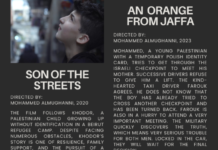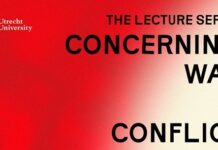Shane Burley & Ben Lorber
+972 Magazine / March 28, 2023
Professor Smadar Lavie discusses the possibilities and contradictions of the Ashkenazi-dominated protests against the government, and traces the efforts of a small cohort of Mizrahi activists to make their voices heard.
Over the past few months, Israeli Prime Minister Benjamin Netanyahu’s radical right-wing coalition government has moved to curtail the independence of Israel’s judiciary and weaken the democratic separation of powers, against the backdrop of a frightening uptick of settler violence against Palestinians in the occupied West Bank. This package of “judicial reforms” is an early sign of what is in store from the most right-wing government in Israel’s history — one in which Kahanists like Itamar Ben Gvir have received high-ranking appointments.
In response to Netanyahu’s attack on the judiciary, an energetic protest movement has developed across portions of Israeli society, with recent massive and unprecedented demonstrations bringing well over half a million Israelis into the streets and, on Monday, a general strike backed by union and business leaders, and reports of a pause on judicial reform legislation. While most protests initially addressed the Netanyahu government’s judicial overhaul, after the Huwara pogrom at the end of February — when settlers rampaged throughout the West Bank Palestinian town, setting homes and cars ablaze and assaulting residents — some protesters have also voiced criticism of settler violence.
Many Palestinian and Israeli activists have rightfully criticized these protests for neglecting to challenge the anti-democratic foundation of Israel’s occupation and apartheid policies. Progressive Mizrahi activists, as well, have charged that protesters have largely overlooked the entrenched oppression of Mizrahi Jews, Jews with origins in Arab or Muslims countries, at the hands of Israel’s mostly Ashkenazi establishment. Indeed, while these protests have served as an important pushback against the anti-democratic agenda of the radical right, they have tended, at least in their early stages, to reflect the interests of a largely secular, urban, liberal Ashkenazi elite — one that is resistant to interrogating its own complicity in longstanding hierarchies that for Palestinians and Mizrahim, have been anything but “democratic.”
The invisibilization of Mizrahi voices in the “pro-democracy” protests, as many have called them, has played right into the strategy of Likud and the Israeli far right, who want to recast their attack on democratic values as an effort to erode Ashkenazi supremacy and elevate the voices of marginalized Mizrahi communities.
Ben Lorber and Shane Burley, two Ashkenazi American-Jewish journalists and activists, spoke with the Mizrahi anthropologist Smadar Lavie, a professor emerita at the University of California, Davis, to understand the contours and deep historical roots of the current crisis of hegemony in Israel-Palestine. With decades of experience in Mizrahi and Palestinian struggles, Lavie is the author of “Wrapped in the Flag of Israel: Mizrahi Single Mothers and Bureaucratic Torture,” a 2018 book that interrogates the racial, religious, and gendered structures of repression targeting the interplay between Mizrahi women and the colonization of Palestine. Lavie discusses with us the possibilities, limitations, and contradictions of Israel’s current protest movement, traces the efforts of the small cohort of left-wing Mizrahi activists to make their voices heard, and unpacks what is needed to transform the status quo in Israel-Palestine and extend the unfulfilled promise of democracy to those to whom it has long been denied.
This interview has been edited for length and clarity.
Ben Lorber: What are the demands of the current “judicial reform” protest in Israel, and who do these protests represent? You have mentioned that Mizrahi Israelis have been largely absent from these protests — something that American leftists may miss. Why are many not a part of these protests?
Smadar Lavie: The protest started as a demonstration led by Israel’s educated Ashkenazi professional upper classes from the legal, engineering, high-tech and biotech, media, art, medicine, and academic fields. Even several dozen West Bank settler professionals have joined the demonstrations.
One of the key characteristics of these demonstrations is the massive usage of the Israeli flag and a stern censorship against waving the Palestinian flag (at least until the Huwara pogrom). Another element of the demonstration is having a mass symbolic signing of Israel’s 1948 Declaration of Independence. Among the key leaders and organizers are former IDF Chiefs of Staff, and former generals who led Israel’s air force, marines, elite commando units, and cyber warfare squads. These are considered the crème de la crème of Israeli society, Ashkenazi by default. Even though Ashkenazim constitute only 30 percent of Israel’s citizenry, they control the division of power and privilege in the state. The protestors demand the return of the Israel they used to have prior to the “Bibidom” [the Netanyahu regime].
According to estimates collected in early February by right-wing pollsters, 26 percent of the demonstrators identified as Mizrahim. I can assume that many belong to the frail emerging Mizrahi middle class who scrambled so hard to get there. This class does not enjoy the intergenerational wealth of the Ashkenazi establishment.
Mizrahi communities form Israel’s demographic majority, but they are far from homogenous. Mizrahim is a coalitional term, like people of color in the United States. But as the majoritarian segment of Israeli society, they determine parliamentary election results. What is considered “center” in Israeli politics keeps moving toward the alt-right, and so does the Mizrahi majority vote that continues to shift toward ultra-nationalism.
Nevertheless, presently there is a blessed initiative led by a group of intellectuals from the small Mizrahi left — the Mizrahi Civic Collective. While the majority of the demonstrators are conservative, privileged Ashkenazim, who wish to return to the good ol’ order of things in a state that paradoxically defines itself as both “Jewish” and “democratic,” the Mizrahi collective calls into question the old order itself. They argue that for Mizrahim and Palestinians with Israeli citizenship, Israel has never been a democracy in structure or in practice. They conceive of these current tumultuous times as an opportunity to reshape the Israeli structure of governance so that it becomes a genuine democracy.
Unlike the mainstream Ashkenazi organizers of the mass demonstrators, they do discuss justice for Palestine. But it’s clear that the focus is on 1967 and forward rather than the Nakba.
I’m so excited by this initiative, yet I worry that this initiative will dissipate and disappear despite the hard work of the scholars and activists on the position papers addressing the proposed Mizrahi economic, political, and cultural reforms to counter the alt-right reforms presently being voted on in the Knesset. This was the fate of the superb research and position papers issued by the Mizrahi component of the huge Occupy movement in 2011 [the so-called “tent protests” when hundreds of people camped out on a major Tel Aviv thoroughfare, and hundreds of thousands more took to the streets, to protest the cost of living].
The majority of Mizrahim vote for right-wing parties, and many live in the hinterlands of the Israeli state. The Mizrahi left, however, is mainly concentrated in Tel Aviv, Jerusalem, and Haifa. Through social media and Zoom conferencing, some of its members assume leadership from New York City or Britain — not exactly effective in forming in-situ solidarities with the here-and-now Mizrahi lived experience in Israel.
A genuine social change can blossom through in-person, in-group consciousness raising — whether gathering in synagogues, community centers, or people’s homes — but I fear that the Mizrahi left is not capable of doing that due to lack of time and space, and mostly due to lack of funds for social movement or NGO organizing. Most Mizrahi feminist activists in the Tel Aviv-Haifa-Jerusalem centers are not homeowners, and struggle with paying monthly rent and utility bills, leaving them little capacity to pursue the organizing needed.
NGOs are so budget dependent, and often there is not enough funding for in-situ Mizrahi left initiatives. If there are donations, they usually come from progressive Zionist donor organizations of the American-Jewish diaspora, and NGOs need to adapt their activism so that they don’t offend the donors. The image diaspora Jews have of Israel is that all Jews are equal in the homeland of the Jews. It would be difficult for them to admit that underneath this imagined equality there is an intra-Jewish racial construction.
Another blessed initiative is a demonstrating block, “The Front of the Non-Represented,” organized by Shovrot Kirot (“Breaking Walls,” Hebrew feminine plural), Israel’s up-and-coming grassroots Mizrahi feminist movement. Their banners declare “No democracy without Mizrahi, Ethiopian, Palestinian women. No democracy without single mothers, refugees and asylum seekers, and without LGBTQ.” They have joined the demonstrations in the last three weeks despite their reservations, stemming from the fact that the Ashkenazi Zionist (and non-Zionist) left has rarely, if at all, joined Mizrahi feminist demonstrations against femicide, evictions of single mothers, and their disconnections from gas and electricity, collection courts robbing Mizrahi homes of the little they have, or the removal of children from Mizrahi single mothers’ homes to forced boarding due to the mothers’ poverty.
They, too, see the present mass protest as an opportunity to propose a new, anti-racist order for Israeli society that emphasizes social justice. An important lacuna of these two initiatives is the absence of a head-on challenge to Israel’s lethal bureaucratic webs. The state deploys cumbersome bureaucratic procedures to control the Mizrahi majority. To democratize the state, there ought to be an alternative model that reduces the stranglehold of the Israeli regime over its majority citizens through labyrinthine bureaucratic rigmaroles.
Even though more Mizrahim are now participating in the demonstrations, I don’t think the majority of middle-class Mizrahim who protest share the politics of the Mizrahi Civic Collective or of Shovrot Kirot. The demonstrations were, fundamentally, about keeping the Israeli legal, political, and economic system as it was before the reign of the Netanyahu governments.
Shane Burley: In a recent article for the London Review of Books, Palestinian scholar Tareq Baconi said, “what worries the protesters is the prospect of the fascist ideology so familiar to Palestinians being turned on Israeli Jews.” This seems to be the history of fascism more broadly, as a potentiality baked into nationalism from the start. How do you think the protesters are misunderstanding the way fascism emerges in Israel? Would you say that perhaps in an analogous way, the liberal Ashkenazi protestors are afraid of being turned into second-class citizens as they have long treated the Mizrahim?
Fascism is immanent to Zionism from its onset and throughout its history.
Historically, the white supremacist far right has drafted its participants by amalgamating ideologies and practices of religiosity and biologism as essences. Biologism might mean here the attempt to define racial, ethnic or other group identities as a hard-wired biological fact. These essences construct Zionism’s ideas and practices of the nation-state. At the basis of white supremacist, fascist movements there is a double standard: the upper-classes initiate it, but then it feeds on the populism of the white lower classes. This populism is rooted in the centrality of the heteronormative family and conservative family values.
Authoritarian regimes depend on an interplay between a strongman, charismatic leader and a bureaucracy that drains much of the resistive agency of the masses through bureaucratic entanglement, oftentimes focusing on activists and racial justice NGOs. This interplay between the strongman leader and the bureaucratic apparatus was there from the days of [first Israeli Prime Minister David] Ben-Gurion and his control of the mass immigration of Jews from the Arab and Muslim worlds through having them rely on the labyrinthine welfare bureaucracy. It was Ben-Gurion who said that the Mizrahim were bands of criminals, alcoholics, and pimps.
Israel has always defined itself as a Jewish state. You can be a Jew either by birth and prove a pure Jewish maternal lineage of five generations, or, rarely, through Orthodox conversion. There is a bias against converts — one passage in the Talmud states that the convert is as much of a burden to the people of Israel as psoriasis, and this has become a commonly spoken Hebrew idiom. Non-Orthodox conversions are not recognized as valid by the rabbinical court system that determines marriages, divorces, religion at birth, and other issues of Israeli-Jewish personal status. A state that defines people’s claim to citizenship through biology and religion is totalistic. And even when biology and religion determine citizenship, dark-skinned men will always be underneath white men, and women will be underneath men. White women will be part of the modernist civilization, and dark women will be considered uncultured and animalistic.
The new Israeli regime wants to outlaw any possibility of abortion; do away with the procedure of issuing restraining orders in cases of domestic violence; eliminate the non-rabbinical courts for divorce; and openly opines that women ought to return to serve their husbands and birth Jewish babies. They plan to undo whatever Israeli feminists, Ashkenazi, Mizrahi, and Palestinian, have achieved after such difficult struggles. While the Israeli secularists protesting want to separate Judaism from the state, the judiciary has regularly ruled in the opposite direction — and the history of so-called secular Zionism itself shows that such a separation is far from straightforward.
SB: The Ashkenazi core of today’s protest movement condemns the Netanyahu regime as a bastion of social conservatism and imagines itself, by contrast, as a beacon of liberalism. It sounds like you’re saying that, while the threat from the far right is real, the ‘enlightened’ self-image among liberal Ashkenazim is misleading, when in reality, strong strands of social conservatism have been there from the beginning.
In Israel’s orientalist imagination, Mizrahim are always portrayed as traditionalist conservatives, while the Ashkenazim portray themselves as beacons of (post)-modernity. But even before Likud came to power in 1977, it was secular, socialist Ashkenazi Zionists who were conservative with their family and gender dynamics, aside from the failed experiment of the kibbutz. All the while they displaced this conservatism as primitivity upon Mizrahi families. Israeli society’s smallest unit of organization is not the Western European-North American ideal of the well-bounded individual, but the nuclear family — be it secular or observant, Ashkenazi, Mizrahi or Palestinian. So desire is channeled towards reproduction, and reproduction is channeled toward bolstering Jewish demographics in the midst of the Arab world. The Hebrew term is pulhan ha-imahut (the cult of motherhood).
You can also observe these reproductive norms in Israel’s LGBTQ community. The American homonormative LGBTQ struggle was for marriage rights. In Israel it was for the right to parenthood — be it by lesbian couples, surrogacy for gay couples, or alternative families. This cult amalgamates biologism and religion: you either are a Jew by birth or a goy [gentile]. If you (re)produce Jews, you and your offspring have the privileges of being the superior citizens of the state. Even “pure” Jews from the diaspora receive automatic citizenship when they immigrate to Israel, including assistance in housing, employment and reduced taxation. All of this was set up since the foundation of the state in 1948.
Israel was always hyper-nationalist, and until the privatization-deregulation of the mid-1980s had a paradox of labor and capital — many of the industries were owned by the Histadrut, who was also Israel’s labor union. Socialist Zionism served the Ashkenazi minority quite well. For Mizrahim, it was exploitation. And, in turn, the Mizrahim exploited the Palestinians. After [the occupation began in] 1967, many Mizrahim enjoyed an upward, economic mobility push, because there was an influx of rightless Palestinian workers from the West Bank and Gaza. Zionism was always a project of expansionism. Nevertheless, this push did not eliminate the structural and cultural racism against [Mizrahim].
But there are so many contradictions in Israeli nationalism, because Jewish halacha [religious law] is intertwined with public policy. No public transport on Shabbat. Big supermarket food chains can’t operate without a kosher license. Citizens cannot marry across religions. Israelis celebrate the Jewish holidays and the so-called secular interpretation of these holidays hijacks Judaism into nationalistic symbology. So the borderline between religion and politics has never been clear. While Mizrahim are stuck with primitive stereotypes of religiosity and traditionalism, the whole state is organized according to a religious ethnocracy — including the secularist Ashkenazi elite.
This kind of Ashkenazi white supremacy is not new. At present, an extreme manifestation of it is noted with the fast alt-right drift toward dictatorship. If these demonstrators want equal rights, it’s for Jews only. Israel was never a democracy for Palestinians, and it would still fail to be in the vision these protesters have for reform. The so-called secular cosmopolitanism touted by many of the demonstrators is enabled by systemic violence against the Palestinians and discrimination against Mizrahim, including those scrambling into the middle classes. In a sense, sadly, the Mizrahi voters for the alt-right can be seen as some sort of second-class white citizens who need to protect their privilege through ultra-nationalism in a Northern world where communities of color acquire power through voice and action, much like parts of the U.S. Trump base. Even though Mizrahim can be classified as people of color, in Israel, they do enjoy Jewish supremacy. Underneath it, however, there has always been a structural preference for European Jews.
BL: Some on the Israeli right criticize these protest movements as an attack against the ascendant political power of Mizrahim by an old Ashkenazi liberal elite, desperate to maintain its grip on power. What is the problem with this analysis, portraying Likud as the defenders of Mizrahim and Netanyahu’s attack on the judiciary as a revolt against Ashkenazi power? What is the source of its appeal — is there a grain of truth in it?
There’s no illusion among the Mizrahi voters who elected this alt-right Knesset and government that they’re trading a liberal Ashkenazi elite for an ultra-conservative one, trading the old guard for a fascist avant-garde. The good outcome is that while the Zionist left was near death, now, with these mass protests, it has come to life again, and it realizes that while Mizrahi elected politicians continue to sell out to the Ashkenazi leadership, it cannot continue to ignore the Mizrahi public as a political force.
Of course, the Israeli judiciary is biased against Mizrahim. One of the grave injustices done to Mizrahim in court is around housing — no-fault evictions, gentrification’s expulsion-demolition. Another is in family and youth courts, often sending lower-class children to forced boarding schools, the same kind of boarding schools as for Aboriginal Australians or Native Americans. Collection courts, acting against Mizrahim in terms of small debts, are another tool of discrimination — they hold so few possessions and [the courts] confiscate it all to sell it at auction to pay such debt, while tech and hedge fund companies’ huge debts are often forgiven.
The people who execute these evictions, the social workers uprooting impoverished children from their homes, are often middle-class Mizrahim. Many judges in the lower courts, traffic courts, and collection courts are also Mizrahim. Oddly, both the Mizrahi alt-right voters and the Mizrahi left initiatives are in agreement about the differential, racially-centered legal system in Israel. Both advocate for legal reforms, however contradictory.
SB: So there is this stratification where the Ashkenazi elite remain on top and are using middle-class Mizrahim to execute these judgements and exploitation of the Mizrahi lower classes, while the upper-class Ashkenazim basically have their debts forgiven.
Yes, exactly. Likud is using Mizrahim who have deep grievances against Israel’s legal system, even as these are its voters who will be hit the hardest from its dictatorial reforms. Paradoxically, as the anti-reform protest develops, some of its leaders are using Mizrahi social justice issues in support of their cause as well. The Ashkenazi left is deploying the multicultural discourse of diversity and inclusion to woo the Mizrahi intelligentsia, assuming the Mizrahi majority will follow. This has recently become their strategy to obscure the manner in which the Ashkenazi leadership — be it hi-tech tycoons or Shimon Peres, Ehud Barak, even Netanyahu — continues to advance a violent economy. The economic boom of the 1993 Oslo Accords served the industrial elite well into Israel’s present image of a high-tech nation. In the era of neoliberalism, both the Ashkenazi left and the right-wing elites are promoting a myth of Jewish, multi-ethnic democracy that obscures the slow genocide of the Palestinians and state violence against the Mizrahi lower classes.
Many Mizrahim understand this manipulation, and that may be the reason for the lack of Mizrahi presence at the beginning of the demonstrations. But now, the biggest game changer is the refusal of elite military reservists to attend to their periodic training. Since the IDF is built on reservists for moments of military crisis, their refusal is reverberating across the military. Nevertheless, it is conceived as another Ashkenazi privilege. In general, being pro-Palestinian in Israel often requires contacts and funds to pay bail rather than rot in prison in case one is arrested during a solidarity visit to West Bank villages.
Such a call from what is dubbed in Israel “the best of our sons,” those who dropped two-ton bombs on Gaza or Beirut to execute one guerrilla leader, is sure to alienate the infantry Mizrahim. Together with Druze, Ethiopians, and post-Soviets, they police the West Bank on a daily basis. They are the ones who were dancing in a Purim party with the settler pogromists who set Huwara on fire. Many of these infantry soldiers are busy with survival, and the ones who will not refuse their reservist duty will probably do it for the small additional income they receive from the IDF during their reserve duty. As of March 12, 70 percent of Israelis from the political center support the refusal of reservists if the legal “reform” passes. This is an average of 31 percent of right-wing Israelis supporting refusal, and 87 percent of left-wing Israelis (mostly Zionist) supporting refusal.
BL: What might happen next, in terms of Mizrahi participation in the protests? Are there grounds for optimism that this might lead to greater equality for Mizrahim and Palestinians?
I’m quite pessimistic as to the future of the Mizrahi impact on the mass protests due to the disconnect between its highly critical intellectual leadership and the majority Mizrahi public who love Israel and deny the occupation of Palestine. When there is vibrant activism, such as that of Shovrot Kirot, it oftentimes focuses on the never-ending, individual crisis situations — fighting against evictions, reconnecting water and electricity, conducting donation campaigns for food and housewares. These actions are so necessary, yet they fall into the category of charity rather than fighting for a change in Israel’s structural racism.
For the Mizrahi victims of the state, love for the Jewish nation hampers efficient mass organization and actions for social change to redeem their citizens’ rights. Another problem is the fact that due to the extreme housing crisis in Israel’s center, where the majority of jobs are located, Israeli governments, be it Likud or Labor, directed Mizrahim out of their gentrified barrios and into the large, urban West Bank settlements. The Mizrahi majority, therefore, will be reluctant to vote for a land-for-peace settlement of the Palestine conflict. This love for and dependency on the state prevents many Mizrahim from speaking and acting against it. When discrimination is so obvious, it becomes elusive. Many in the frail new Mizrahi middle class even flatly deny it. So perhaps like my Afro-pessimist friends, after decades of scholarship and activism, I’ve become a Mizraho-pessimist.
Shane Burley is the author of Fascism Today: What It Is and How to End It (AK Press, 2017) and Why We Fight: Essays on Fascism, Resistance, and Surviving the Apocalypse (AK Press, 2021)
Ben Lorber works as senior research analyst at the social justice think tank Political Research Associates, researching antisemitism and white nationalism












